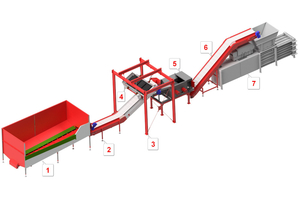10. 8. 2019
Separation line for waste metal

The effective sorting of packages is very important from environmental and economical point of view. A big quantity of the thrown away packages can be processed repeatedly. We have delivered one of our lines also to an establishment in the capital city dealing with cartage and processing of waste in Prague.
Customer´s submission
- Separation of beverage cans and other types of cans Al + Fe from yellow containers intended for beverage cans
- Aluminum can 15 – 18 g
- Iron can 60 – 70 g
- The required capacity 300 tons / year, operation 5 days a week
- Shift 7.5 hours = 160 kg / hour
- Press aluminum separated into the bundles
During the personal visit on-site we found out that there were also stewed fruit tins and beer casks of the volume of 5 l occurring. After launching-on the line also other compoes as for for example glass (bottles), wood plastic, spray tins, polythene etc. turned out to occur in the material to be separated. Principally it was a municipal waste.
Requirement for separation
Pour out the materials being on the car (volume of 30m³) directly to the feed hopper of conveyor-belt transporting the material into the bundle presser. During this way carry out the separation of the iron share of the material by the magnetic separator, after that separate aluminum cans therefrom the remaining material via Eddy Current (working on the principle of so called turbullent currents). In the first stage separate the iron canes therefrom other material (aluminum cans, glass, plastic etc.). In the second stage separate the aluminum cans from other material (glass, plastic, wood, etc.). And as the last transport the clean aluminum cans without other materials into the presser and press them into bundles to be processed further.
Description and operation of the sorting line
The sorting line consists of input feed hopper (notice 1) where the compo intended for separation is dumped. Drug chain conveyer starts to extract the material that is subsequently squeezed in and goes on further to the belt conveyer. There is a two-man operating staff standing at the belt conveyor (notice 2) and they carry out the visual inspection of the material to be separated and draw off the material that the line is not able to process (big steel parts, paper packing material, wood etc.) . After approximately 2 metres space for operating staff the conveyer folds. There is a steel construction (notice 3) positioned above the angular part on which the DND-AC Ms3F magnetic plate (notice 4) sorting the steel material is hung. The steel material is thrown into the the shipping container prepared. The remaing material devoid of feromegnetic particles falls on vibrating feeder advances to the eddy-current separator (notice 5) subsequently. The eddy-current separator segregates nonferrous metals (aluminum, copper) subsequently from the remaining small material. Nonferrous metals travel on the belt conveyer (notice 6) that ends above the feeding hopper of the presser (notice 7). The presser smashes the separated material into so called packet that is bound subsequently and detruded outwards. The presser has also a side feeding hopper prepared where also other types of materials (PET bottles, cardboards, steel bottles, plastics) can be pressed.
 Scheme of sorting line
Scheme of sorting line
- Sorting line input feeding hopper
- Belt conveyer
- Steel structure
- Self-cleaning magnetic plate
- Eddy-current separator – non-magnetic metal separator
- Belt conveyer for nonferrous metals
- Presser feeding hopper of material under separation
